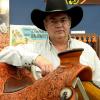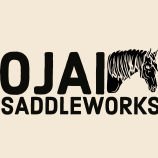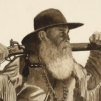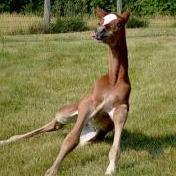-
Posts
468 -
Joined
-
Last visited
About kseidel
- Birthday 02/25/1965
Contact Methods
-
Website URL
http://www.seidelsaddlery.com
Profile Information
-
Gender
Male
-
Location
Cody, Wyoming
-
Interests
Fishing, Hunting, Riding Horses, Shooting, Reloading, Silversmithing, Camping, Traveling, Art,
LW Info
-
Leatherwork Specialty
Saddlemaking
-
Interested in learning about
other leatherworkers
-
How did you find leatherworker.net?
random search
Recent Profile Visitors
16,526 profile views
kseidel's Achievements

Member (2/4)
-
Davm, Most of what you are dealing with most likely is relative to leather temper. Casing leather and getting the right temper for stamping can be challenging! Then add that different stamps need different temper and you are well on your way into the rabbit hole! The specific stamps you are using will also have an impact on the final look. I do not use a modeling spoon on any of my floral carving. Only swivel knife, and stamping tools.
-
Davm, Some pics would help to troubleshoot your work. There are a lot of variables, but I can probably give you some useful pointers if you can post a few pics of your work. Keith
-
You are very kind! I started in the leather business in 1976. Bought my first stitcher in 78, built my first saddle in 79. I made saddles for years before doing any stamping. Learned to stamp from Billy Gardner in 1985. It feels like forever at this point, but I have been stamping for 37 years! The important thing to remember is that I have made my living in this business full time for all those years. It takes a LOT of hours of stamping and constant study to improve to develop this level of skills. Thanks for the compliments. Keith
-
To reference your beveling question, All of your beveling should be done before any decorative stamps are used. (ie: cams, veins, liners, mule tracks, etc.) You can use cams with or without flutes, or veiners usually fluted, for decorating the swirls. Studying the work of others will give you several options. Keith
-
Different styles of carving/stamping uses different types of stamps. Same with swivel knives. Angle blades have little use in floral carving while they can be very useful in figure carving. If you are only doing borders for geometric stamping, then a wider thicker blade is better. My favorites are Ole' Smoothie by Chuck Smith. I have shorter fingers, so I prefer a 3/8" barrel that is 3¾" long from base inside yoke to tip of blade. This knife is not adjustable so must be purchased for length. Chuck offers a blade made from COBALT that is superior to carbon steel for reduced drag while carving. It is comparably priced to competitors yet is a much better quality knife. His contact info is Chuck Smith, 760-749-5755, Mobile:760-535-5191. Keith
-
Professional's perspective: While the swivel knife body is not really that critical to a beginner, the blade can make or break your experience. A sharp blade ground at the correct angle and polished to a mirror surface is important for smooth cutting in the leather. Most budget blades are ground on coarse wheels and are impossible to make satisfactory cuts. You will not be able to create a design that looks anything like you want and you will get discouraged real quickly. I have found it impossible even for a professional to get satisfactory results from hobby stamping tools. I know it is a significant investment, but quality tools are worth what they cost. On a side note, you can always recoup your investment in quality tools, while cheap tools have little to no resale value. What style of carving and stamping are you wanting to try? Keith
-
You can get them directly from Blevins in Wheatland WY. They will sell direct in small quantities. Keith
-
There are a lot of differences in the styles that you referenced. Mainly relative to the time period when these saddles were in production and their usage. Much is relative to the evolution of American saddle making over the past 150 years. The Hope style is one of the earliest of the "western" style of saddles. It is a hybrid combination of European and American plantation style saddles with some of the earliest examples of carved/stamped decorations in the leather found in America. Horned saddles were not necessary until post Civil War when wild cattle were rounded up and driven to market, marking the beginning of the "cowboy" era. Basically all saddles were slick fork swells until the turn of the last century, when shaped swells began to show up by innovative saddlemakers to meet the demands of the cowboys. The Mexican Vaquero influence can also be seen in the early southwestern saddles and can be credited for some of the development of our modern Wade saddles with the large post horn. The "Wade," as we know it, did not show up till about 1940. Visallia Saddle Co. make very popular slick fork saddles with steel horns from the late 1800's thru the 50's. Their 3B is still a very popular slick fork swell still today. Much of this can be researched using old saddle catalogs. Keith
-
Ante up and buy some flower center stamps. They are worth the investment. Keith
-
Generally speaking, acorn/oak is more forgiving and patterns can be easier to draw and do not have as much variety and detail in the elements of the pattern, and do not require as many tools. There are many styles in the field of floral carving. Some are fairly simple and basic, while others are very detailed and intricate. They are totally different styles and appeal to different clients. Preferences can be somewhat geographic.
-
There are no set "rules" on how you should run these tools. I like to cut the outside line and bead to the inside. I do not cut the second bead line, but rather press it quite deep and go back and forth to create a deep burnished bead with the tool. I like to push bevel the outside cut line away from the bead. You can cut your line and place your bead any distance from the edge that you want. This is all relative to how you design your pattern.
-
The tool you are describing is not a push beader, but rather an edge creaser. An edge creaser has one longer leg that hangs off the edge of the leather, and a shorter leg that makes a crease in the leather. This is usually not a very sharp tool and makes a slightly rounded groove in the leather but does not cut thru the surface. A beader has two sharp edges of the same length with a rounded groove in the middle. Either edge can be placed into a swivel knife cut and pushed into the leather along the cut line. The second line actually cuts into the leather and leaves a rounded "bead between these two lines. A beader blade does the same thing but is designed to put into a swivel knife.
-
You ask how the professionals do this... we do not use a stitch groover to cut tooling lines. We use a swivel knife to cut the first line marked with a wing divider, and then follow up with a beader blade or a push beader to create the parallel line with a rounded "bead" between the lines.
-
The technique you are describing is called a blind stitch. It is very common with cutters and show saddles. It can be done very well and holds up well. The swell cover is fitted on the tree and cut so the edges butt together. Then the cover is removed and stitched together from the back side with the threads going thru the leather diagonally and not breaking the surface. Things to be aware of when covering a swell this way.... 1) do not fit the swell cover too tight to the tree. The leather will shrink when it dries and if too tight it will pull a gap in the seam and the stitches will show. 2) Keep stitches close together. No more than 1/4 inch between stitch holes. 3) use thick swell cover so there is enough thickness for stitches. You don't want the stitches to be closer to the surface than the epidermis layer of the hide. I have made a lot of saddles with blind stitched swells. Good Luck. Keith
-
This style of rubber hammer is very effective for forming swell covers over undercut swells. It really helps to work out those wrinkles. It works best to pull as much slack into the hand hole and front gullet as possible before trying to sweat the cover over the rest of the swell.








.thumb.jpg.5b075c18cced41a3c20e51759823bf7f.jpg)
.thumb.jpg.383759422550dc56bf4482b8e429e0e3.jpg)